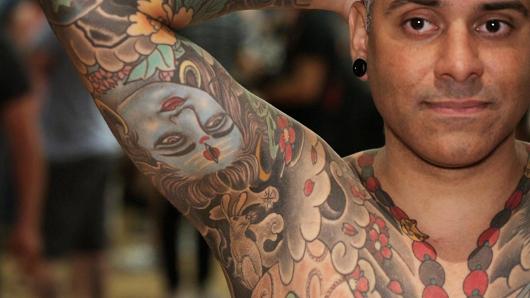New Association Offers Deceased and Family The Option to Preserve Skin Art
Article originally appeared on Forbes and NAPSA
With the announcement of a new nonprofit organization dedicated to preserving skin art, tattoos may finally take their place among other works of art as collectibles passed down through the generations. The National Association for the Preservation of Skin Art (NAPSA) just launched a program allowing people who join to receive the benefit of post-mortem tattoo preservation. While this brings tattoo collecting into the 21st century, the history of the practice dates back at least several centuries.
Although there is debate about which mummies preserve the earliest known examples of a tattoo, some of the less controversial examples include Ötzi the “Iceman” found in the Tyrolean Alps and the Pazyryk Maiden found in Siberia. The cold climates naturally mummified their remains, leaving archaeologists with some of the most stunning examples of preserved tattoos in antiquity.

The mummy of an iceman named Otzi, discovered on 1991 in the Italian Schnal Valley glacier, is displayed at the Archaeological Museum of Bolzano on February 28, 2011 during an official presentation of the reconstrution. (Andrea Solero/AFP/Getty Images)
Ötzi’s body has been studied for decades. When he died in about 3300 BC, he boasted 61 tattoos, all linear or cross-shaped. Anthropologists who have researched the body and its cultural context think that the placement of the tattoos is important: they are near areas of the body that may have caused Ötzi pain, such as his spine and Achilles tendon. In fact, many of the tattoos are similar in location to acupuncture points. Although Ötzi’s tattoos weren’t made with a needle — they were made from rubbing charcoal into incisions — it is likely he underwent this process not for signalling of his personality or affiliation with a group but rather for therapeutic reasons.
Another famous tattooed mummy is the Pazyryk Ice Maiden, also called the Ukok princess. This Iron Age (5th century BC) woman, found in the Altai Mountains of Siberia, was buried in an elaborate grave that included numerous artifacts and six horses. The combination of the cold climate and natural embalming with peat and bark preserved her clothing and, of course, her skin. Sleeves of tattoos cover her arms, full of stylized and mythological animals. As this culture was primarily reliant on pastoralism, the abundance of animals is unsurprising, even as the sheer elaboration of those animals is unique and breathtaking.

Princess Ukok/Princess of the Altai: A mummy that was found in 1993 in a kurgan in the remote Ukok Plateau in the Altai Republic in Russia, which is now the subject of a fight about her future atatus between the republic Altai and its inhabitants on one side and the Novosibirsk Institute of Archeology and Ethnography (and the Russian Academy of Sciences in general) on the other side. (Public domain image via wikimedia commons.)

Prof. Luc Renaut from the University of Poitiers, France, shows some body marks during the conference “Into the Skin” – Identity, Symbols and History of permanent body marks. (AP Photo/Pier Paolo Cito)
From more recent cultures, there are examples of mummified heads of New Zealand’s Māori. Called mokomokai, these preserved heads show the practice of tā moko tattooing. In the traditional Māori culture, the heads of deceased family members would be dried out and preserve for special ceremonies, although some were the remains of enemy chiefs and were mocked rather than venerated. Then in the 18th century, European traders would buy mokomokai from the Māori or barter for ammunition. These heads became so popular that sometimes slaves and prisoners were forcibly tattooed and killed in order to boost the supply of mokomokai.

THE PRESERVATION OF ART, SKIN & SOUL
This past weekend, BTSOE had one vendor that really impressed me. Who was it? Read up and find out.
What will you leave your family when you pass? Memories? Pictures? Perhaps a video montage? Well Save My Ink now gives people a chance for members to leave a piece art, while leaving a piece of them – literally.
Art is as much about creation, as it is about preservation. Regardless of the discipline of art you practice or collect, there will always be those who create it, those who collect it, and those who spread the history. In the same breath,it is that word which will soon be passed from one generation to the next, and in turn it becomes the chronicles of our culture and a part of history.

With that said, the culture of tattoos is no different. Each day that passes, there is an untold story waiting to be shared, and so long as it is accurately told and represented, then the future artisans of the world will have a better idea as to how our art came to be.
While historians aim to educate and inform, collectors on the other hand, keep in their possessions the artifacts of time. We have the ancient ruins in which art is scribed in stone, and when it comes to art on paper or canvas, we have those who keep them in their private collections and museums who keep them in their galleries. But when you stop to think about the medium of tattoos, it’s an art form which typically dies with us simply because it’s on our skin – till now.

The gents over at Save My Ink have created an ingenious way to preserve our tattoos and they have now given us the ability to share not only a piece of art, but a piece of ourselves, which in turn can be passed on from one generation to the next. Consider it an art, a moment frozen in time, but we consider it something much more powerful: A legacy.
Though some may be appalled, or a little disturbed by the service, it is a gift of personal treasures – literally. In essence, getting one of your tattoos framed and preserved is much more visual, and much more personal than having the ashes of your loved one contained in an urn, and it’s a gift that provides a visual reminder of a piece of art which once adorned your loved ones body.

When I first heard about this service, this past weekend at BTSOE, we were impressed. It’s an incredible service of preservation, and in all honesty, it’s the most sacred gift one can give to loved ones and not only a memoriam of art – but soul.
In a statement, they said, “We want to provide resources and support [our members] may not otherwise have access to,” Charles Hamm, NAPSA executive director and chairman of the group’s board, said in the news release, which references a 2012 Harris Interactive poll that suggests one in five American adults has at least one tattoo, a 14 percent increase from the Nielsen group’s 2008 survey.
According to the release, removing a tattoo from one of its member’s deceased bodies involves “a chemical and enzymatic process that permanently alters the chemical structure, thus permanently fixing it against decomposition (while preserving the integrity of the art).” The group said the final product isn’t classified as tissue and isn’t toxic.They further added, “This process rejuvenates the art and brings it back to essentially its original look”.
I’m glad to have met the gents over at Save My Ink and I can’t thank them enough for giving me a personal tour of their gallery. The experience was uplifting, mesmerizing and I wish them nothing but the best in their endeavor. To have someone think outside the box and give us the ability to give a gift that keeps on giving, is priceless and I encourage all of you to check them out. You can visit their official sit by clicking here.
SO HOW DOES IT WORK?
The tattoo removal process begins within 18 hours of a member passing, whereby the designated beneficiary alerts NAPSA. From there, NAPSA sends paperwork and a package with the removal kit to the member’s funeral home overnight. Within 60 hours, a mortician that agrees to participate follows provided instructions to remove the tattoo, placing it in a nontoxic, temporary preservation compound, and returns it to the NAPSA. The organization then preserves the art and sends it to the beneficiary, who receives a certificate for his or her participation, within six months.




